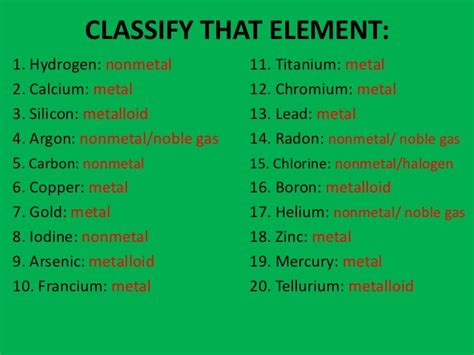Is Argon Metal Nonmetal Or Metalloid
Muz Play
Apr 02, 2025 · 4 min read

Table of Contents
Is Argon a Metal, Nonmetal, or Metalloid? A Comprehensive Exploration
Argon, a noble gas with the symbol Ar and atomic number 18, is unequivocally a nonmetal. This classification stems from its fundamental physical and chemical properties, which sharply contrast with those of metals and metalloids. Understanding this categorization requires delving into the defining characteristics of each group. This article will explore the properties of argon and compare them to the characteristics of metals and metalloids, definitively establishing its nonmetallic nature.
Understanding the Classification of Elements
The periodic table organizes elements based on their atomic structure and resulting properties. Broadly, elements are categorized into metals, nonmetals, and metalloids (also called semimetals). Each group exhibits distinct behaviors:
Metals
Metals are typically good conductors of heat and electricity, possess a lustrous appearance, are malleable (can be hammered into sheets), and are ductile (can be drawn into wires). They often have high melting and boiling points and tend to lose electrons in chemical reactions (forming positive ions). Examples include iron, copper, and gold.
Nonmetals
Nonmetals, in contrast, are generally poor conductors of heat and electricity, lack a metallic luster, and are often brittle. They have low melting and boiling points and tend to gain electrons in chemical reactions (forming negative ions). Examples include oxygen, chlorine, and sulfur.
Metalloids
Metalloids exhibit properties intermediate between metals and nonmetals. Their conductivity can vary depending on factors like temperature and pressure. They are often semiconductors, meaning their electrical conductivity lies between that of metals and nonmetals. Examples include silicon, germanium, and arsenic.
Argon's Properties: A Nonmetal Profile
Argon, a colorless, odorless, tasteless gas, demonstrably fits the profile of a nonmetal. Let's examine its key characteristics:
1. Electrical and Thermal Conductivity:
Argon is an extremely poor conductor of both heat and electricity. This low conductivity is a hallmark of nonmetals, stemming from its electronic structure. Unlike metals with freely moving electrons, argon's electrons are tightly bound to their respective atoms, hindering the flow of charge.
2. Physical State and Appearance:
At standard temperature and pressure, argon exists as a gas. It lacks the characteristic luster associated with metals. Its colorless and odorless nature further reinforces its nonmetallic classification.
3. Melting and Boiling Points:
Argon has a very low melting point (-189.3 °C) and a low boiling point (-185.8 °C). These low values are typical of nonmetals. Metals, in comparison, generally possess significantly higher melting and boiling points.
4. Chemical Reactivity:
Argon is a member of the noble gases, also known as inert gases. This signifies its exceptional chemical inertness. Its outermost electron shell is completely filled, making it exceptionally stable and unreactive. This reluctance to participate in chemical reactions is a defining characteristic of nonmetals, particularly the noble gases. It doesn't readily lose, gain, or share electrons. This is in stark contrast to metals, which readily participate in chemical reactions.
5. Crystal Structure:
While solid argon doesn't exhibit the ordered, metallic crystal structures found in metals, it forms a face-centered cubic structure, a characteristic seen in many nonmetals.
Argon vs. Metals and Metalloids: A Comparative Analysis
To definitively solidify argon's classification as a nonmetal, let's directly compare its properties to those of metals and metalloids:
Argon vs. Metals:
| Property | Argon (Nonmetal) | Metal |
|---|---|---|
| Conductivity | Very poor | Excellent |
| Appearance | Colorless, odorless gas | Lustrous |
| Malleability | N/A (gas) | High |
| Ductility | N/A (gas) | High |
| Melting Point | Very low | Generally high |
| Boiling Point | Very low | Generally high |
| Chemical Reactivity | Extremely low | Generally high |
The stark contrast in properties clearly distinguishes argon from metals.
Argon vs. Metalloids:
| Property | Argon (Nonmetal) | Metalloid |
|---|---|---|
| Conductivity | Very poor | Intermediate (semiconductor) |
| Appearance | Colorless, odorless gas | Variable appearance |
| Malleability | N/A (gas) | Moderate to low |
| Ductility | N/A (gas) | Moderate to low |
| Melting Point | Very low | Variable |
| Boiling Point | Very low | Variable |
| Chemical Reactivity | Extremely low | Moderate to low |
Even when compared to metalloids, argon's extremely low conductivity, inertness, and gaseous state firmly place it outside the metalloid category. Metalloids show some degree of metallic character which is entirely absent in argon.
Conclusion: Argon's Unwavering Nonmetallic Identity
Based on its physical and chemical properties, especially its extremely low conductivity, lack of metallic luster, low melting and boiling points, and extreme chemical inertness, argon definitively belongs to the nonmetal group. There is no ambiguity in its classification; its properties strongly align with the defining characteristics of nonmetals and strongly contrast with those of metals and metalloids. The argument for argon being anything other than a nonmetal is unsupported by experimental evidence and contradicts the fundamental principles of chemical classification. Its place within the noble gas family further cements its nonmetallic identity.
Latest Posts
Latest Posts
-
Light Amplification By The Stimulated Emission Of Radiation
Apr 03, 2025
-
Octet Rule Violation Vs Wrong Electron Total
Apr 03, 2025
-
What Are The Three Points Of Cell Theory
Apr 03, 2025
-
How Many Atoms Are In A Simple Cubic Unit Cell
Apr 03, 2025
-
Boiling Point Is A Chemical Property
Apr 03, 2025
Related Post
Thank you for visiting our website which covers about Is Argon Metal Nonmetal Or Metalloid . We hope the information provided has been useful to you. Feel free to contact us if you have any questions or need further assistance. See you next time and don't miss to bookmark.
